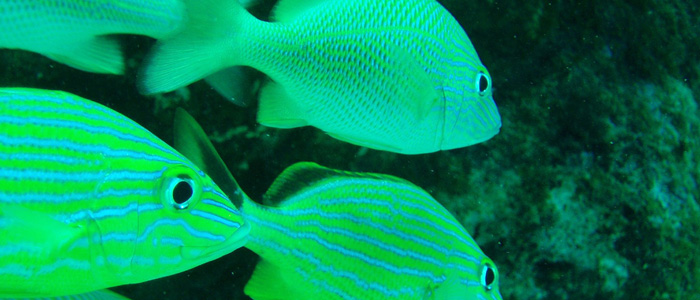Reef Animals
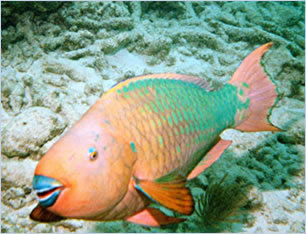 What animals are you likely to encounter on the reefs off Key Largo? Well, our reefs are home to over 260 species of tropical fish and around 80 species of coral, not to mention countless other invertebrates. In terms of fish, some of the most commonly encountered are parrotfish, wrasses, damselfish, snappers, grunts, and barracudas. Invertebrates commonly seen on the reefs include lobster, sea cucumbers, urchins, shrimp, and anemones. For most people, the most impressive coral varieties are brain coral, mountainous star coral, elkhorn coral, and sea fans. This variety of marine life provides spectacular opportunities for underwater photography!
What animals are you likely to encounter on the reefs off Key Largo? Well, our reefs are home to over 260 species of tropical fish and around 80 species of coral, not to mention countless other invertebrates. In terms of fish, some of the most commonly encountered are parrotfish, wrasses, damselfish, snappers, grunts, and barracudas. Invertebrates commonly seen on the reefs include lobster, sea cucumbers, urchins, shrimp, and anemones. For most people, the most impressive coral varieties are brain coral, mountainous star coral, elkhorn coral, and sea fans. This variety of marine life provides spectacular opportunities for underwater photography!
PARROTFISH occur in about 15 varieties that are frequently spotted on the reefs of the Florida Keys Reef Tract. For most of those species, however, the males and female are different colors, and often the juveniles are at least one other color, leading to somewhere around 50 different color varieties, any color of the rainbow (and in the case of Rainbow Parrotfish, all of them!). The fish tend to complicate things by making an amazing change towards the end of their life, too. Many parrotfish (along with wrasses and groupers, among others) are protogynous sequential hermaphrodites. This means that nearly all hatch out as females, and when there is a shortage of reproductive males, each female has the ability to change into a male! This involves a major color and size change (among other things!) but after about a week and a half, they are fully functioning males. This means that most of the male fish sighted on the reef used to be female! The parrotfish have a heavy beak formed from their front teeth growing together, and are primarily herbivorous, scraping reef-growing algae off the rocks. In doing this, they grind a lot of the limestone rock up in their stomach, which eventually travels through the digestive tract. Parrotfish end up excreting roughly 60% of our beach sand!
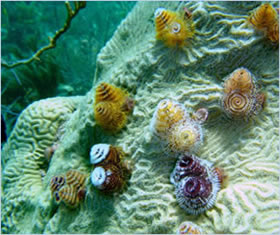 Close relatives of the parrotfish, WRASSES even look like miniature versions of their cousins. Like parrotfish, wrasse are generally protogynous hermaphrodites, but unlike parrotfish, most start out on the reef working as "cleaners". These juvenile wrasse will form a "cleaning station" around a coral head waiting for larger fish to approach and indicate that they want to be cleaned. Upon the right signal (frequently flaring gills and occasionally changing color), the cleaners will approach the larger fish and swarm all over its body, picking off parasites and removing dead skin, a very important part of preventing disease on the reef. Some cleaners are especially daring: juvenile Spanish Hogfish (one of the largest wrasse species in the Keys) are known for cleaning the mouths of Green Moray Eels!
Close relatives of the parrotfish, WRASSES even look like miniature versions of their cousins. Like parrotfish, wrasse are generally protogynous hermaphrodites, but unlike parrotfish, most start out on the reef working as "cleaners". These juvenile wrasse will form a "cleaning station" around a coral head waiting for larger fish to approach and indicate that they want to be cleaned. Upon the right signal (frequently flaring gills and occasionally changing color), the cleaners will approach the larger fish and swarm all over its body, picking off parasites and removing dead skin, a very important part of preventing disease on the reef. Some cleaners are especially daring: juvenile Spanish Hogfish (one of the largest wrasse species in the Keys) are known for cleaning the mouths of Green Moray Eels!
DAMSELFISH are found nearly everywhere on the reef, and are sighted on every snorkel or dive. The most common species include the zebra-striped Sergeant Major, the colorful juvenile Cocoa Damsels, and the ubiquitous Bicolored Damsel. Damsels are generally small (smaller than your hand) but they don’t know it! To the contrary, these are the only animals that are likely to "attack" you while snorkeling! Damselfish fiercely defend garden patches of algae on the reef, and if you get too close to the bottom, they will come up and dance in front of your mask to scare you away! Don’t worry, they’re harmless; in fact, they put on quite a show if you stick around to watch.
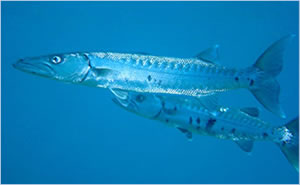 SNAPPERS and GRUNTS are frequently confused with each other by snorkelers and divers, and with good reason. They are very similar in body shape and color; close enough, in fact, that they are often found schooling together. These schools can be very impressive, covering the entire sea floor in between coral ridges. Both get their names from fishermen; snappers tend to snap at fisherman when pulled up in a net, whereas grunts will grate bony plates together in their throats to make a loud, pig-like grunting noise.
SNAPPERS and GRUNTS are frequently confused with each other by snorkelers and divers, and with good reason. They are very similar in body shape and color; close enough, in fact, that they are often found schooling together. These schools can be very impressive, covering the entire sea floor in between coral ridges. Both get their names from fishermen; snappers tend to snap at fisherman when pulled up in a net, whereas grunts will grate bony plates together in their throats to make a loud, pig-like grunting noise.
Yes, we do have GREAT BARRACUDAS here! They are seriously nasty-looking predators, up to 7 feet in length, with a full mouth of sharp teeth. The good news is, as far as we’re concerned…it’s all just show. Barracudas primarily feed on fish about two to three inches long, and rarely would go after anything healthy (too much work for them!). If you head out on the snorkel boats, you will often see people removing jewelry before getting in the water. While this may be a good idea to keep from losing anything, it won’t have much impact on the barracudas (they can see A LOT better than that, especially in our clear water). They may be curious, but they are not a threat to snorkelers or divers. Of course, you don’t have to tell your friends that when you show them your pictures later!
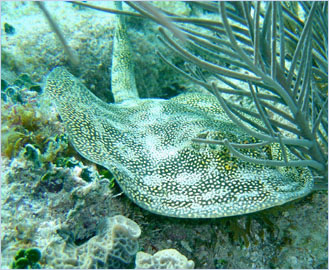 SEA CUCUMBERS, SEA URCHINS, and BRITTLE STARS are all members of the Phylum Echinodermata, which are all animals with spiny skins and a water vascular system. Sea cucumbers are present on most reefs, but a good sighting is rare during the day, because they usually hide within the cracks of the reef. Sea urchins are more commonly sighted; although numbers of the Caribbean Long-spined Urchin, Diadema antillarians, greatly declined in the 80’s, they are making a recovery on our reefs, and more commonly snorkelers see the Rock-boring Urchin and Sea Egg (which frequently make protective "sun hats" out of sea floor debris). Brittle stars, relatives of the sea stars, are usually reclusive, but can sometimes be found out during the day by checking the mouth of tube sponges and looking under ledges. They occur in any color imaginable, and at night many divers discover that the hairs on their legs are bioluminescent (glow in the dark)!
SEA CUCUMBERS, SEA URCHINS, and BRITTLE STARS are all members of the Phylum Echinodermata, which are all animals with spiny skins and a water vascular system. Sea cucumbers are present on most reefs, but a good sighting is rare during the day, because they usually hide within the cracks of the reef. Sea urchins are more commonly sighted; although numbers of the Caribbean Long-spined Urchin, Diadema antillarians, greatly declined in the 80’s, they are making a recovery on our reefs, and more commonly snorkelers see the Rock-boring Urchin and Sea Egg (which frequently make protective "sun hats" out of sea floor debris). Brittle stars, relatives of the sea stars, are usually reclusive, but can sometimes be found out during the day by checking the mouth of tube sponges and looking under ledges. They occur in any color imaginable, and at night many divers discover that the hairs on their legs are bioluminescent (glow in the dark)!
The Class Crustacea in the Phylum Arthropoda contains the CARIBBEAN SPINY LOBSTER, various types of CLEANER SHRIMP, and ARROW CRABS, all of which can be found hiding under ledges on our reefs. Spiny Lobster are protected on most of the snorkel reefs, and so can grow to enormous size there, topping two feet from rostrum to tail. On the other end of the size spectrum, Arrow Crabs are usually no more than three inches across and at first appear to be all legs and no body! The cleaner shrimp, such as the Pederson’s Cleaner Shrimp, are frequently found inside sea anemones (such as the GIANT ANEMONE) from which they operate their cleaning station. Divers and snorkelers have reported having their fingers cleaned on several occasions.
If you come to the park to try your hand at underwater photography, remember that the biggest and best-known trick is to use the light to your advantage. Colors tend to fade to blue over fairly short distances underwater in the absence of bright lights. The best time of day for natural-light photography is around 10:30 or 11:00, when the sun is climbing and many of the larger animals are still active. If you can, use a flash; doing so will double the colors in your pictures! Otherwise, remember the three rules: get CLOSE, get LOW, and shoot UP. Approach your subject slowly, and don’t waste the film until you get close enough to get those colors. Once you get close, dive down below your subject (if possible) and shoot at an upwards angle, with that beautiful blue water forming the perfect backdrop. Remember these little tricks, and you’ll be shooting some great pictures in no time!

